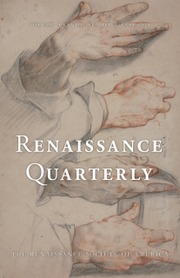This detailed study of Thomas More’s formative years demonstrates how More’s life choices were governed from the outset by his literary interests and his unswerving religious faith. Thomas More’s Vocation opens as a tour of London: Tower Hill, where More was beheaded; Lincoln’s Inn, where he studied law; St. Lawrence Jewry, where he gave lectures on Augustine’s City of God; the Palace of Westminster, where, as the new Speaker of the House of Commons, he defended freedom of speech in 1523; and Chelsea Old Church, his last parish church.
An enigmatic Latin sentence, taken from a text called “the October letter,” serves as the uniting thread running through a great part of the book, and, Mitjans proposes, reveals More’s early and unwavering vocation. Linking More’s life to his writings, the second chapter recalls his meeting and friendship with Erasmus and John Colet, his love of the classics, his enthusiasm for Lucian, and his use of Boethius. However, throughout the book, Mitjans highlights More’s independent attitude towards his sources. The influence of Augustine is then finely analyzed in a number of More’s works—namely Utopia, the Dialogue Concerning Heresies, and some later works. Moreover, not only Augustine’s City of God but also John Chrysostom’s idea of the city and his stress on the importance of human work are shown as constitutive of the way More devised the utopian city life.
After two more chapters devoted to More’s early works, from his Latin epigrams to his Life of Pico, the focus is on “Some Books Recommended by Thomas More,” such as Bonaventure’s Life of Christ, Gerson’s Imitation of Christ and Monotessaron, Hilton’s Scale of Perfection, and Thomas Aquinas’s various works. It was More’s vocation to have chosen a combination of the active life with the contemplative, a trend that was becoming more common as, Mitjans notes, the fourteenth and fifteenth centuries witnessed a “consistent process of assimilation by the laity of techniques and materials for spiritual advancement that had historically been virtually the preserve of religious orders” (140–41). Laity versus priesthood is the topic of a whole chapter, which tackles More’s correspondence with his fellow European humanists, such as John Colet. More’s stay at the London Charterhouse (1499–ca. 1504) is a period in his life that has been understood differently by his various biographers, his supposed hesitation between priesthood and marriage remaining a moot point.
About his lectures on Augustine’s De civitate Dei, when More was only twenty-one, Mitjans comes to the conclusion that “Erasmus is our best guide,” for he explained how More took up De civitate Dei’s central theme of the two cities. The eighth chapter ends on Vives’s praise of More. The topic of More’s dilemma is resumed when Mitjans focuses on his double attraction to literature and spirituality, action and contemplation. The author highlights how that dilemma had been part of More’s outlook since his younger years, until “he chose the life of service to society and the contemplative life of a Christian” (207, emphasis in original). More and marriage is the topic of the tenth chapter, with views taken from Augustine and Erasmus’s Enchiridion milites christiani, among others. This is followed by the last chapter, entitled “Life’s Pilgrimage,” devoted to Thomas More’s sainthood. Though his study concerns More’s younger years, Mitjans proposes a final analysis of his last work, De tristitia Christi, reflecting on the analogy between a life of prayer and a pilgrimage. Before offering documentation on More’s two epitaphs as an appendix, Thomas More’s Vocation concludes on More’s awareness that “the Christian vocation implies a mission toward others,” but “though such awareness requires a personal and individual response, ‘the first point is to love but one alone,’ it brings with it, at least in the case of More, the realization that such a vocation is ‘common to the whole Christian people’” (254).
Thomas More’s Vocation is a well-documented analysis of More’s early writings and intentions, with particular emphasis upon Christian perspectives of interpretation. Nonetheless, this study will be equally useful to scholars who work on More’s writings and to readers who wish to be enlightened about More’s spirituality.



